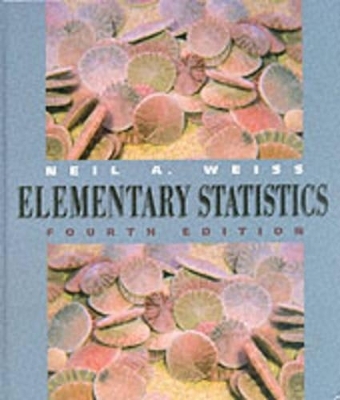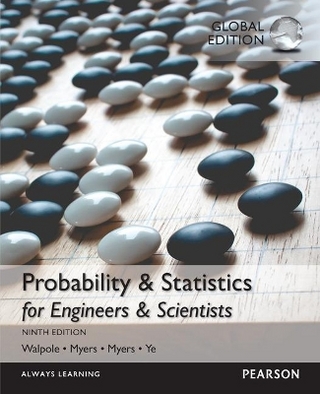
Elementary Statistics
Pearson
978-0-201-59878-0 (ISBN)
- Titel erscheint in neuer Auflage
- Artikel merken
Now in its Fourth Edition, Weiss has a reputation for being thorough andprecise, and for using real data extensively throughout.
Weiss Elementary Statistics is appropriate for a one-semesterintroductory statistics course. The Fourth Edition gives students a solidintroduction to statistics through a streamlined approach to probability thatprepares learners for more advanced topics. This course is useful and reality-based, employing technological tools such as Minitab® Release 12, theTI-83 graphing calculator, Excel, and the Internet to investigate statisticalproblems.
I. INTRODUCTION.
1. The Nature of Statistics.
Case Study.
General Objectives.
Chapter Outline.
Two Kinds of Statistics.
Classifying Statistical Studies.
The Development of Statistics.
Using the Computer.
Is a Study Necessary?
Simple Random Sampling.
Other Sampling Procedures.
Experimental Design.
Internet Project.
Using the Focus Database.
Case Study Discussion.
Biography.
Chapter Review.
Review Test.
II. DESCRIPTIVE STATISTICS.
2. Organizing Data.
Case Study.
General Objectives.
Chapter Outline.
Variables and Data.
Grouping Data.
Graphs and Charts.
Stem-and-Leaf Diagrams.
Distribution Shapes; Symmetry and Skewness.
Misleading Graphs.
Internet Project.
Using the Focus Database.
Case Study Discussion.
Biography.
Chapter Review.
Review Test.
3. Descriptive Measures.
Case Study.
General.
Objectives.
Chapter Outline.
Measures of Center.
The Sample Mean.
Measures of Variation; the Sample Standard Deviation.
The Five-Number Summary; Boxplots.
Descriptive Measures for Populations; Use of Samples.
Internet Project.
Using the Focus Database.
Case Study Discussion.
Biography.
Chapter Review.
Review Test.
4. Descriptive Methods in Regression and Correlation.
Case Study.
General Objectives.
Chapter Outline.
Linear Equations with One Independent Variable.
The Regression Equation.
The Coefficient of Determination.
Linear Correlation.
Internet Project.
Using the Focus Database.
Case Study Discussion.
Biography.
Chapter Review.
Review Test.
III. PROBABILITY, RANDOM VARIABLES, AND SAMPLING DISTRIBUTIONS.
5. Probability and Random Variables.
Case Study.
General Objectives.
Chapter Outline.
Introducing Probability.
Events.
Some Rules of Probability.
Discrete Random Variables; Probability Distributions.
The Mean and Standard Deviation of a Discrete Random Variable.
The Binomial Distribution.
Internet Project.
Using the Focus Database.
Case Study Discussion.
Biography.
Chapter Review.
Review Test. @CHAPTER 6. The Normal Distribution.
Case Study.
General Objectives.
Chapter Outline.
Introducing Normally Distributed Variables.
Areas Under the Standard Normal Curve.
Working With Normally Distributed Variables.
Assessing Normality; Normal Probability Plots.
Internet Project.
Using the Focus Database.
Case Study Discussion.
Biography.
Chapter Review.
Review Test.
7. The Sampling Distribution of the Mean.
Case Study.
General Objectives.
Chapter Outline.
Sampling Error; the Need for Sampling Distributions.
The Mean and Standard Deviation of X—The SamplingDistribution of the Mean.
Internet Project.
Using the Focus Database.
Case Study Discussion.
Biography.
Chapter Review.
Review Test.
IV. INFERENTIAL STATISTICS.
8. Confidence Intervals for One Population Mean.
Case Study.
General Objectives.
Chapter Outline.
Estimating a Population Mean.
Confidence Intervals for One Population Mean When s Is Known.
Margin of Error.
Confidence Intervals for One Population Mean When s Is Unknown.
Internet Project.
Using the Focus Database.
Case Study Discussion.
Biography.
Chapter Review.
Review Test.
9. Hypothesis Tests for One Population Mean.
Case Study.
General Objectives.
Chapter Outline.
The Nature of Hypothesis Testing.
Terms, Errors, and Hypotheses.
Hypothesis Tests for One Population Mean When s Is Known.
P-Values.
Hypothesis Tests for One Population Mean When s Is Unknown.
Internet Project.
Using the Focus Database.
Case Study Discussion.
Biography.
Chapter Review.
Review Test.
10. Inferences for Two Population Means.
Case Study.
General Objectives.
Chapter Outline.
The Sampling Distribution of the Difference Between Two Means forIndependent Samples.
Inferences for Two Population Means Using Independent Samples(Standard Deviations Assumed Equal).
Inferences for Two Population Means Using Independent Samples(Standard Deviations Not Assumed Equal).
Inferences for Two Population Means Using Paired Samples.
Internet Project.
Using the Focus Database.
Case Study Discussion.
Biography.
Chapter Review.
Review Test.
11. Inferences for Population Proportions.
Case Study.
General Objectives.
Chapter Outline.
Confidence Intervals for One Population Proportion.
Hypothesis Tests for One Population Proportion.
Inferences for Two Population Proportions Using Independent Samples.
Internet Project.
Using the Focus Database.
Case Study Discussion.
Biography.
Chapter Review.
Review Test.
12. Chi-Square Procedures.
Case Study.
General Objectives.
Chapter Outline.
The Chi-Square Distribution.
Chi-Square Goodness-Of-Fit Test.
Contingency Tables; Association.
Chi-Square Independence Test.
Internet Project.
Using the Focus Database.
Case Study Discussion.
Biography.
Chapter Review.
Review Test
13. Analysis of Variance (ANOVA).
Case Study.
General Objectives.
Chapter Outline.
The F-Distribution.
Analysis of Variance: The Logic.
Analysis of Variance: The Procedure.
Internet Project.
Using the Focus Database.
Case Study Discussion.
Biography.
Chapter Review.
Review Test.
14. Inferential Methods in Regression and Correlation.
Case Study.
General Objectives.
Chapter Outline.
The Regression Model; Analysis of Residuals.
Inferences for the Slope of the Population Regression Line.
Estimation and Prediction.
Internet Project.
Using the Focus Database.
Case Study Discussion.
Biography.
Chapter Review.
Review Test.
Appendixes.
Appendix A: Statistical Tables.
I. Random numbers.
II. Areas under the standard normal curve.
III. Normal scores.
IV. Values of t….
V. Values of X2….
VI. Values of F….
Appendix B: Answers to Selected Exercises.
| Erscheint lt. Verlag | 28.1.1999 |
|---|---|
| Zusatzinfo | Col.ill.ch. |
| Sprache | englisch |
| Maße | 207 x 242 mm |
| Gewicht | 1670 g |
| Themenwelt | Mathematik / Informatik ► Mathematik ► Statistik |
| ISBN-10 | 0-201-59878-7 / 0201598787 |
| ISBN-13 | 978-0-201-59878-0 / 9780201598780 |
| Zustand | Neuware |
| Haben Sie eine Frage zum Produkt? |
aus dem Bereich

